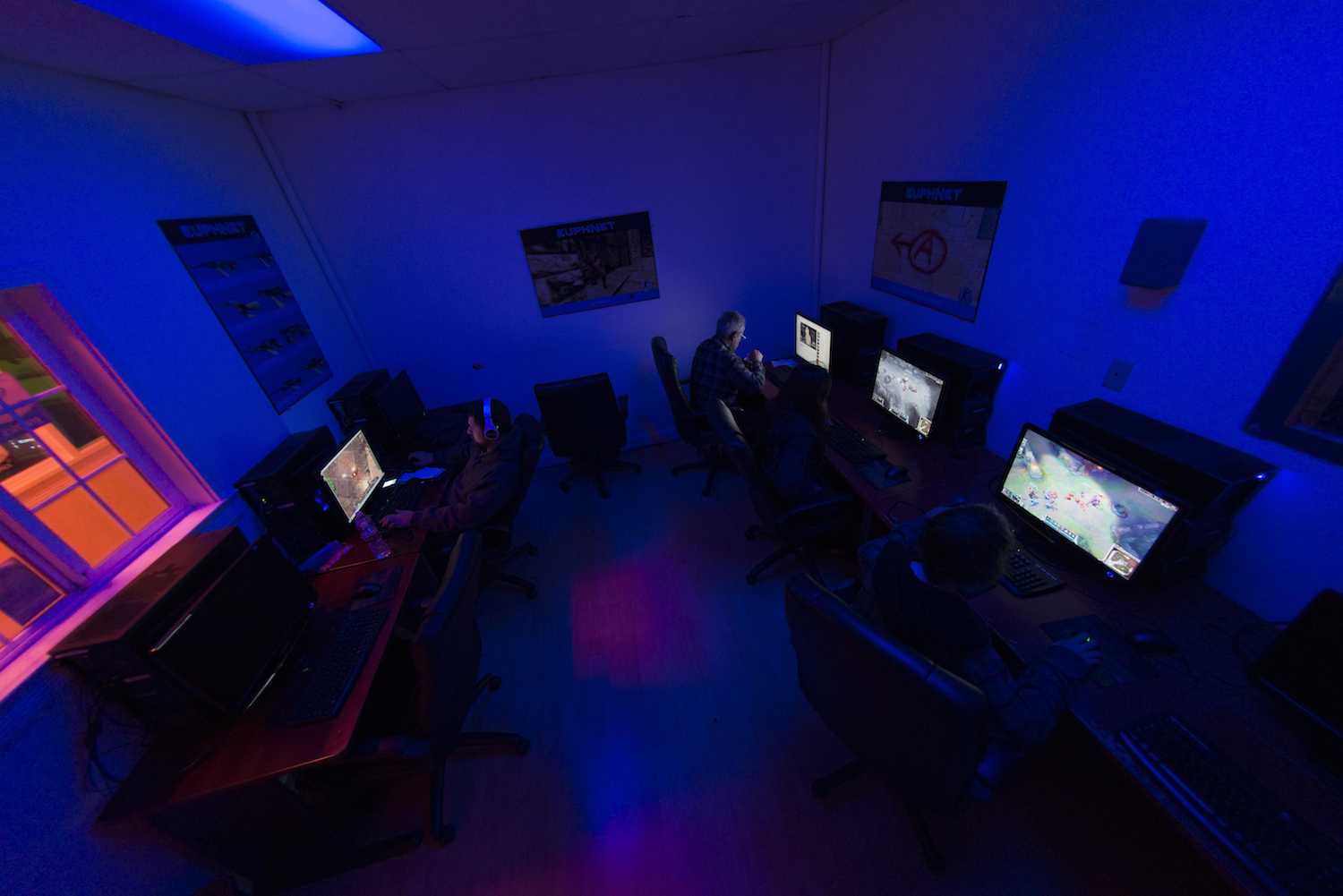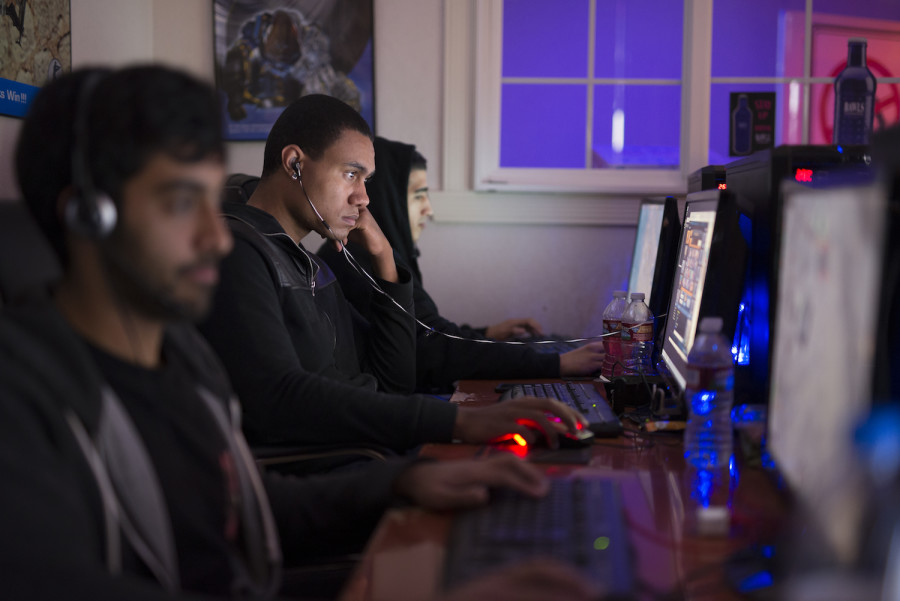Game on!
January 28, 2015
Phalanxes of window-shades block the early evening sunlight from entering the small, L-shaped front room of Sunnyvale’s Euphnet Cybercafe. Eerie blue rays from an array of screens invade a dark space filled with computers and gamers, projecting their halos onto rows of male faces staring back at the monitors arranged around the perimeter of the room. On the screens, images of fantastic places, from leafy green jungles to hellish lava-filled terrains, flash by focused pairs of eyes. Football commentary for a game between UCLA and Colorado State blares on hidden speakers, and a tackled Bruins player falls to the turf on the large projection screen overlooking the room. Nobody seems to take notice. All the players sport headsets as they lean forward in sleek leather and chrome office chairs. They hover over dark brown wooden tables, tapping the keyboards with darkly silhouetted left hands, moving computer mouse in precise, almost imperceptible motions with their right. Rapid bursts of clicks overlay the din of the football commentator every second. Besides the yellow incandescent lamp mounted to illuminate the concession counter and a blue orb light that hangs from the ceiling, the players sit glued to their games in darkness.
Casual gaming, e-sport tournaments, and colossal online universes beckoning for conquest: welcome to the world of Silicon Valley gaming, where the once solitary activity of playing video games has been rapidly evolving into a social one. In fact, a 2008 study by the Pew Research Center indicates that only 25 percent of game-playing teenagers play video games alone — visual interaction is rapidly evolving into the norm instead of the exception.
At Euphnet, gamers gather to play Massive Multiplayer Online Role Playing Games (MMORPG’s), in which competitors from around the world explore a single online universe together. The cafe’s arsenal of powerful computers, each armed with high-end Intel processors and dedicated chips for processing graphics, draws players looking for faster, smoother gaming experiences than they might have with their own machines. Despite their immersion in the digital multiverse, Euphnet general manager Brian Cuerdon identifies these players as “casual gamers” who don’t compete for prize money.
“There definitely is a thriving community for e-sports,” Cuerdon said. “But the [gamers here] just come in to play with friends and just to kill time rather than playing for any league, tournament, or prize money. Weekends are very crowded, more [so] towards the evening time. We get a good amount of high school kids, but… now it’s more 18 to 25 year olds that are playing now.”
Situated next to a quiet suburb, Euphnet, the only self-identified cybercafe in the Bay Area, caters to local players looking for a casual experience. However, in organized e-sport tournaments, teams of serious players compete for thousands of dollars in prize money playing games such as League of Legends (LoL) and World of Warcraft (WoW). Opposing players scattered across continents might never meet face-to-face, but gamers from the same team wouldn’t need to see each other either. Instead, players can control their avatars from the comfort of their homes and with a few taps of their keyboards. One e-sport tournament organizer, the High School League (HSL), offers scholarships from a large prize pool to successful high school teams.
“[Each year], we’re going to bring the best teams from the around the US, Canada… they’re going to fight each other online,” HSL assistant manager James Kozachuk said. “And from there, we actually call out top teams to Grand Del Mar in [San Diego], California… to play for tons of scholarship money.”
In HSL’s 2013 League of Legends playoff tournament, 620 high school teams from across the nation played in a 3-round tournament for the chance to compete at San Diego. Only the finalist teams travelled to compete in person, and the company awarded $15,000 in college scholarships to the top four finishers.
“I first got involved with HSL when I heard one of my friends talking about making an official League of Legends team. Usually, people play League just for fun, but it was interesting to think about how we could bring gaming to the next level,” League of Legends player Anthony Luo (‘16) said.
Anthony stated that he practiced around four hours a week preparing for LoL competitions but eventually left the team in his junior year to focus on schoolwork.
“I definitely can’t say that I finished all of my homework before playing League, and many times the practice conflicted with the times I reserved for homework,” Anthony said. “However, by constantly checking myself from playing too much, I was able to move past these conflicts and maintain a healthy balance between school and my gaming in League.”
Calvin Kocienda (‘16) also competed in HSL, playing his first tournament in his freshman year. He described the competition environment as challenging but forgiving to newcomers.
“My feelings in the first thirty seconds [of an HSL match] were of real honest anxiety, because I knew that the people in the competition were likely a lot better than me,” he said, describing an HSL tournament he competed in two years ago. “But that just made me want to win even more. Overall, I knew I would have fun, win or loss.”
Some gamers have the opportunity to continue their careers in college. This year, Robert Morris University in Illinois became the first college to provide scholarships to League of Legends players.
The finalists of HSL’s gaming tournaments find an international audience for their skills when their matches are broadcast live on the Internet. Cuerdon stated that thousands of spectators watched the HSL’s San Diego finals on the live video game streaming site, Twitch.
“There’s a lot less people that are watching our contests than are watching the best [gamers] from around the world,” Cuerdon said, estimating that 1,000 to 5,000 spectators regularly view HSL broadcasts. Anthony stated that he watches replays and live streams of games on Twitch.
“[The videos] are usually the most exciting moments of the game or the most interesting parts,” Anthony said. As both a member of the chess club and a gamer, Anthony compared watching a video game to viewing a chess match.
With their collaboration-friendly gameplay and massive spectator presence, games such as LoL, WoW, and Minecraft have an integral interaction component as part of their playing experience. Dr. Romeo Vitelli believes that the role-playing aspect of these games allows players to step into the shoes of different characters.
“[MMORPG’s] provide an opportunity to play a role very different from our real lives – a chance to escape from reality [and] the problems we might be experiencing,” Dr. Vitelli said. “A chance to lead a different life, basically.”
Dr. Vitelli, a psychologist working in private practice in Toronto, emphasized the potential social benefits of video games in a February 2014 story published in Psychology Today. In the piece, he describes how video games provide a setting to practice social skill such as cooperation.
“As computing power and memory capacity grow, software becomes more sophisticated; that allows greater [social] interaction,” Dr. Vitelli said. “As younger generations and more and more people become involved, I think we’ll see more video games… in broad, mass culture.”
Whether they’re challenging the mind or providing a means to attend college, video games have become more than pastimes for a few. They grace the Museum of Modern Art. At the intersection of the physical and virtual worlds, they are contests of skill. And they continue to dominate the lives of many Silicon Valley inhabitants.
This piece was originally published in the pages of Wingspan on January 28, 2015.



